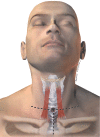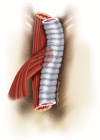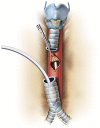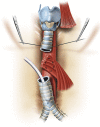Surgery for intrathoracic tracheoesophageal and bronchoesophageal fistula
- PMID: 30023373
- PMCID: PMC6035972
- DOI: 10.21037/atm.2018.05.25
Surgery for intrathoracic tracheoesophageal and bronchoesophageal fistula
Abstract
Benign tracheoesophageal fistula (TEF) results from an abnormal communication between the posterior wall of the trachea or bronchi and the adjacent anterior wall of the esophagus. It can be acquired or congenital. The onset of the TEF has a negative impact on the patient's health status and quality of life because of swallowing difficulties, recurrent aspiration pneumonia, and severe weight loss. Several acquired conditions may cause TEF. The most frequent is prolonged orotracheal intubation (75% of the cases). Usually, there is an erosion of the tracheal and esophageal wall by the continuous pressure between the endotracheal tube and the esophageal wall; particularly in the presence of a nasogastric or feeding tube within the esophageal lumen. Furthermore, tracheal stenosis is often associated, and adds complexity to the disease. Preparation for the surgical procedure may take weeks or even months. It includes definitive weaning from mechanical ventilation, treatment of respiratory infection, physiotherapy, and correction of malnutrition through enteral feeding. Surgical repair of a TEF is an elective procedure. It consists of division of the fistula, suture of the esophagus and trachea and protection of the suture lines with a buttressed muscle flap. TEF repair is a complex and challenging procedure, thus, high morbidity and mortality are expected. Nonetheless, surgical management yields excellent long-term results, and it should be considered the first-line treatment for this condition. Definitive fistula closure occurs in about 90-95% of the cases.
Keywords: Trachea; tracheal stenosis; tracheoesophageal fistula (TEF).
Conflict of interest statement
Conflicts of Interest: The authors have no conflicts of interest to declare.
Figures










References
-
- Couraud L, Ballester M, Delaisement C. Acquired tracheoesophageal fistula and its management. Semin Thorac Cardiovasc Surg 1996;8:392-9. - PubMed
Publication types
LinkOut - more resources
Full Text Sources
Other Literature Sources
